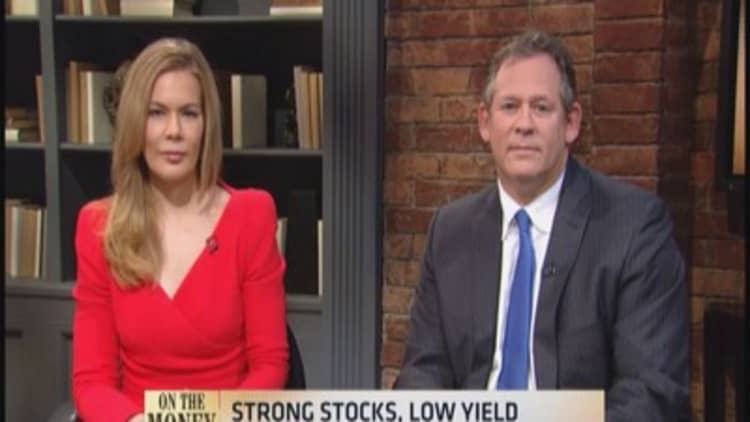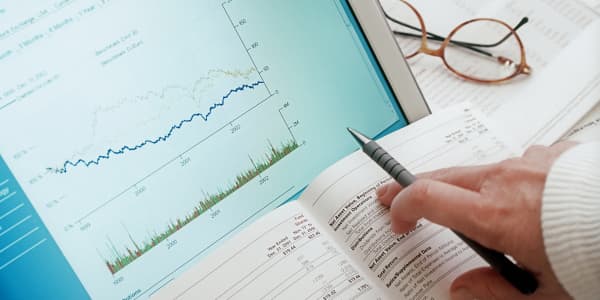Income investors have enjoyed a nice run. In six of the last eight years, yields have fallen and the 10-year Treasury bond returned more than the interest it paid. Other investments with a yield have done well too. But this year shapes up as a challenge.
For one thing, yields have again fallen to near historic lows, and most experts believe a reversal is inevitable. "Long term, there is only one direction rates can go from here," said Lane Jones, chief investment officer at Evensky and Katz/Foldes Financial Wealth Management in Coral Gables, Florida. "Our approach is to remain defensive and not reach for yield."
The U.S. economy shows signs of gaining momentum, and the Fed has signaled it will boost short-term rates later this year. That would provide further upward pressure on bond yields, leaving fixed-income investors vulnerable to loss of principal.
Yet a reversal is by no means certain. The T-bond's stingy 1.8 percent yield looks juicy next to government bonds yielding half as much in Europe and Japan. Foreign buying could push bond prices up and yields even lower for a while, especially if the dollar remains strong. Depressed oil prices also tend to work against the case for higher bond yields by tamping down inflation worries.
Still, the prevailing view is for modestly rising yields this year, which means income investors already earning little return need to be more careful about where they put their money. Here's a look at some of the most popular income options:
Bonds
Any income portfolio should have bonds for stability and diversification, and also because no one really knows where interest rates are going. Wall Street is littered with experts who mistakenly forecast higher rates last year. Making a big bet on direction is often a mistake. But not all bonds are created equal—even though they all seem overvalued early in 2015.
Corporate junk bonds have the highest yields and may appear most tempting. Top-performing junk bond funds, like Vanguard High-Yield Corporate and Federated High Yield, sport yields above 5 percent. This group has gotten more attractive after slumping in recent months. But the yield premium over Treasuries and investment-grade corporate bonds remains historically slim. "You're not getting paid much for the extra risk," said Jacob Wolkowitz, investment manager at Accredited Investors in Edina, Minnesota.
Read MoreHow to get your bonds ready for a Fed rate hike
The problem is that other options don't look great, either. The paltry 10-year Treasury bond yield doesn't offer much cushion against loss of principal if yields rise. Investment-grade muni bond funds look attractive—but only for investors in the highest tax bracket, where the effective yield is around 3 percent. Your best bet in the bond world might be investment-grade corporates, which offer relative safety and a yield near 3 percent. The fund yields 2.5 percent, sticks with high quality and has an average maturity of 5.6 years—which most bond pros say is in the sweet spot on the yield curve.
Dividend stocks

The stock market has a lot to offer yield investors in an environment where the economy is expected to grow at about 3 percent, which should underpin share prices while allowing companies to keep raising their dividend. But as with bonds, advisors say not to stretch for the highest payouts.
Read MoreGet ready for return of Nasdaq 5000
"Shy away from those with the highest dividend yields," said Tom Fredrickson, a fee-only financial planner in Brooklyn, New York. Unusually high yields suggest a company is struggling and may cut its dividend. Meanwhile, he added, "if interest rates rise, bonds will become more attractive," and investors will sell these stocks to get the income they want with less risk. He would avoid, for example, AT&T now yielding about 5.5 percent. He is also looking beyond utilities, which are traditional yield stocks but posted big returns last year and seem vulnerable.
Individual stocks with a history of raising their dividend include Johnson & Johnson, Emerson Electric and Coca-Cola, all with dividends around 3 percent. Other choices to consider: Vanguard High Dividend Yield or iShares Select Dividend, both ETFs yielding around 3 percent and holding stocks that should keep raising their payouts.
Alternatives
The rest of the income world offers a mixed bag that may be best held as part of a diverse income portfolio. Real Estate Investment Trusts had a great 2014 and appear expensive. Like junk bonds, they offer a slim yield premium over Treasuries for the risk. For exposure, consider iShares Dow Jones U.S. Real Estate, an ETF.
Master limited partnerships (MLPs) are mostly tied to the oil and gas industry, which is in a funk, with oil near $45 a barrel. Avoid those with yields above 10 percent, a signal they may cut their payout. Consider capturing this group's attractive income through Alerian MLP, an ETF with a 6.5 percent yield. Warning: MLPs come with complicated tax rules and may be best held in an IRA.
Read MoreEnergy MLPs in the red: Investors running scared
Preferred stocks offer yields in the 5 percent to 6 percent range but give you little of the upside of common stocks. They also come in many flavors that may be difficult for individuals to vet. Here again, an ETF like PowerShares Preferred Portfolio, recently yielding 5.9 percent, might be the best choice.
Read MoreThe ETF boom: Better way to own stocks?
"I like all these strategies, and they work best when combined," said Jack Ablin, chief investment officer at BMO Private Bank in Chicago. In this low-yield environment, income investors have to look beyond traditional vehicles, which do little more than keep up with inflation. Holding a range of income investments, he said, "can give you a higher yield than traditional bonds with similar risk and which will adjust as rates rise."
—By Dan Kadlec, special to CNBC.com




